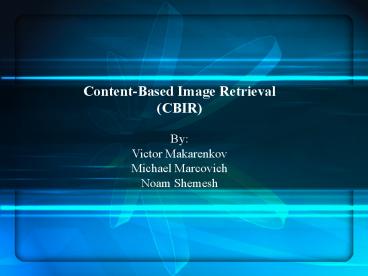P1258716690OCtfa - PowerPoint PPT Presentation
1 / 9
Title:
P1258716690OCtfa
Description:
Content-based image retrieval, a technique which uses visual contents to search ... changed several times during our experiments did not make dramatic changes, but ... – PowerPoint PPT presentation
Number of Views:30
Avg rating:3.0/5.0
Title: P1258716690OCtfa
1
Content-Based Image Retrieval (CBIR) By Victor
Makarenkov Michael Marcovich Noam Shemesh
2
What is CBIR
- Content-based image retrieval, a technique which
uses visual contents to search images from large
scale image databases according to users'
interests, has been an active and fast advancing
research area since the 1990s. - In our project we concentrated on
region-histogram features to retrieve the images
according to an example query image supplied by
the user.
3
- Histogram is a measure used to describe the
image. In simple words it means the distribution
of color brightness across the image. The
brightness values range in 0..255. - Region based means that the histogram measure is
not taken globally for the whole image, but
locally for different image regions. This
region-histogram features were used as index of
the image database. - Weighting for the regions. The closer the part
to image center the higher its weight in
similarity measure.
4
General CBIR system works according to the
following schema
In our CBIR system we implemented all the parts
except the one of relevance feedback.
5
- Visual content description since we using
histogram of image, - we transform the file of the image to its bitmap
representation. - That means 2D array where each cell contains
- a triple with the RGB brightness values for the
colors - Red,
- Green,
- Blue.
6
Feature Vector
- Feature vectors In our system, for generality
purposes we assume that the images are of fixed
size 200200 pixels. (If not our system converts
them to that size). We use local histogram
values. The image is divided into N N square
areas, and then the histogram computed in each
area.Each area is of size (200/N)(200/N) pixels
.Each image is represented with NN length vector
where each coordinate is the histogram in the
appropriate area. More precisely and .
7
- Similarity comparison for a similarity
comparison we used the Minkowski distance.
Minkowski distance between 2 images I and J is
denoted as while we started our research when
p2. - Indexing and retrieval for all images that are
in the databases the feature vector is
pre-computed and stored as index in file. When
retrieval should be made, the image with the
least Minkowski (most similar images) distance
between query image and image from database is
returned.
8
- Conclusions
- As we thought at the beginning Histogram is
quite primitive and insufficient way for CBIR
purposes. However, with certain image
characteristics it may be useful, and works well.
For example on the military ceremony and the
nature images. - Another important foundation we made is that one
of our initial assumptions was wrong. It is that
dividing the image into many area , does not
always improve the results of retrieval. In case
of too many divisions, it degrades the results.
The reason for that is that while comparing small
parts, that are corresponding between the images
and are at fixed place, they can be different.
But if the same picture can be shifted, and not
be found! The method is not shift invariant! - In some cases , small division (4 areas) did
help. For example on the image of Barcelona it
moved a similar shifted building up 1 in rank. - The "Minkowski distance" that was changed several
times during our experiments did not make
dramatic changes, but moved some further images
close when P is enlarged. - May be used to tuning when similar content image
exists, but is not ranked top. Enlarging P in
that case can "push" its rank higher.
9
- References
- Dr. Fuhui Long, Dr. Hongjiang Zhang and Prof.
David Dagan Feng. Content Based Image Retrieval. - Dr. Fuhui Long, Dr. Hongjiang Zhang and Prof.
David Dagan Feng . An Effective Region-Based
Image Retrieval Framework - Yossi Rubner, Carlo Tomasi, and Leonidas J.
Guibas The Earth
Mover's Distance as a Metric for Image Retrieval































